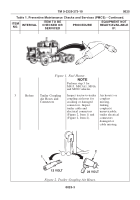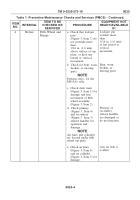TM-9-2320-273-10 - Page 303 of 452
FLUID LEAKAGE
It is necessary for you to know how fluid leakage affects the status of the M915
through M920 and M915A1 vehicles. Following are types/classes of leakage you need
to know to be able to determine the status of the M915 through M920 and M915A1
vehicles. Learn these leakage definitions and remember - when in doubt, notify your
supervisor. Equipment operation is allowed with minor leakage (Class I or II).
Consideration must be given to fluid capacity in the item/system being
checked/inspected. When in doubt, notify your supervisor.
When operating with Class I or II leaks, continue to check fluid levels as required in
the PMCS.
Class III leaks should be reported immediately to your supervisor.
(1) Class I Seepage of fluid (as indicated by wetness or discoloration) not great
enough to form drops.
(2) Class II Leakage of fluid great enough to form drops, but not enough to cause
drops to drip from item being checked/inspected.
(3) Class III Leakage of fluid great enough to form drops that fall from item being
checked/inspected.
PREVENTIVE MAINTENANCE CHECKS AND SERVICES (PMCS)
The Preventive Maintenance Checks and Services Work Package (WP 0025) includes
inspection and service procedures that must be performed to maintain the vehicle in
good operating condition.
TROUBLE SPOTS
Check bolts, nuts, and screws. If loose, tighten. If bent, broken, or missing, notify your
supervisor.
Check painted surfaces. If paint is loose or chipped, or rust is observed on bare metal
surfaces, notify your supervisor.
Check welds. If cracked or broken, notify your supervisor.
Check electrical wiring. If connection is loose, tighten. If insulation is cracked or
broken, wires are bare, or connections are broken, notify your supervisor.
Check hoses and fluid lines. Ensure clamps and fittings are tight. If hoses or lines are
worn, damaged, or leaking, notify your supervisor. Refer to Class Leakage Definitions
for information about leaks.
TM 9-2320-273-10
0024
0024-3
Back to Top




















